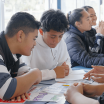Design options for expression and communication
Action and Expression guideline
On this page:
On this page:
Current page section: Design options for expression
Go to top of current page: Design options for expression
Go to top of current page: Design options for expression
Go to top of current page: Design options for expression
Why this matters
Why this matters
Design learning environments that value multiple and novel modes of communication.
This will reduce barriers and enable every learner to share their knowledge, understanding and ideas (CAST, 2024).
Design options for expression and communication prompts us to consider learner variability at the outset and offer options to:
This guideline also reminds us to consider:
- How will these options support learners in reaching their goals?
- Could any of these options create barriers or unnecessary challenges?
- Will all learners have fair and equal access to high-quality choices?
- How do these options reflect and respond to learner variability?
Use multiple media for communication
Use multiple media for communication
Encourage learners to express what they know using different media, such as audio or graphics, unless a specific format is essential to the goal (CAST, 2024).
Encouraging learners to express understanding using multiple media:
- reduces media-specific barriers to communication and expression experienced by disabled learners
- demonstrates respect for forms of communication that have historically been devalued, such as oral storytelling or movement
- increases opportunities for learners to demonstrate their strengths, prior knowledge, skills and expertise and in different media
- increases opportunities for every learner to develop a wider range of expression and skills in a media-rich world.
Source: Use multiple media for communication: UDL Guidelines 3.0 | CAST (2024) (opens in a new tab/window)
Use multiple tools for construction, composition, and creativity
Use multiple tools for construction, composition, and creativity
Provide access to a variety of tools.
Relying only on traditional tools can narrow who can succeed (CAST, 2024).
Build fluencies with graduated support for practice and performance
Build fluencies with graduated support for practice and performance
These scaffolds can be gradually reduced as learners gain confidence and independence (CAST, 2024).
Build learner fluency (ease of showing what I know and can do) by using a range of formative assessments and supportive scaffolds.
Consider how you can utilise a range of supports, such as:
- provide different ways to reach the same goal using varied strategies, skills, or approaches
- provide access to a range of supporters (a buddy in the same class, an older learner, another adult) who can offer support, motivation, and feedback
- offer scaffolds that support learners at different levels and can be gradually removed as independence grows (for example, built-in supports in digital tools)
- provide access to formative assessment opportunities so learners can check their own progress
- give feedback that is flexible and can be tailored to meet individual learning needs.
Address biases related to modes of expression and communication
Address biases related to modes of expression and communication
Consider how different ways of communicating are valued.
Valuing multiple forms of expression and communication creates opportunities for all learners to contribute and participate in learning, CAST (2024):
- Reflect on the modes of expression and communication (print, digital text, image, movement, AAC, NZSL, closed captions, audio) that are offered to learners.
- Reflect on how storytelling and non-text-based forms of expression and communication are valued.
- Discuss with learners how different modes of expression that align with the goal are equally valued.
Useful resources
Useful resources

Design options for expression and communication (UDL Guideline)
This UDL guideline helps educators design learning environments that value multiple and novel modes of expression and communication.
This guideline supports the UDL Action and Expression principle.
Publisher: CAST (2024)
Next steps
More suggestions for implementing the strategy “Design multiple means of Action and Expression”:
-
Current page Design options for expression
Return to the guide “Universal Design for Learning”

How to use this site
Guide to Index of the guide: Universal Design for Learning
Understand:
- Why UDL is valuable
-
Find out about UDLShow suggestions for Find out about UDL
Strategies for action:
-
Design multiple means of EngagementShow suggestions for Design multiple means of Engagement
-
Design multiple means of RepresentationShow suggestions for Design multiple means of Representation
-
Design multiple means of Action and ExpressionShow suggestions for Design multiple means of Action and Expression
- Design options for interaction
- Design options for expression
- Design options for strategy development
-
How to plan using UDLShow suggestions for How to plan using UDL
-
Design considerations in primary settingsShow suggestions for Design considerations in primary settings
-
Design considerations in secondary settingsShow suggestions for Design considerations in secondary settings
-
Design considerations in NCEA assessmentsShow suggestions for Design considerations in NCEA assessments

